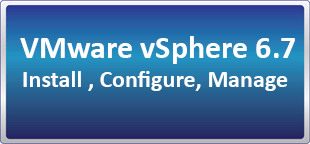بوت کمپ نوروزی VMware vSphere 6.7 Install, Configure, Manage

خلاصه دوره
دوره VMware vSphere ICM 6.7 به جهت آشنایی مدیران و مهندسین شبکه با تکنولوژی مجازی سازی سرورها توسط VMware vSphere 6طراحی شده است. در این دوره دانشجویان با نصب و راه اندازی سرویس دهنده های VMware ESXi و VMware vCenter و به صورت عملی آشنا خواهند شد .
مدت دوره:
40 ساعت
پيش نياز:
دارا بودن تجربه عملی در زمینه مدیریت یک سیستم عامل Server ، آشنایی با مدیریت بستر شبکه و یا گذراندن دوره های زیر :
- CCNA
- MCITP یا MCSE
اهداف دوره:
آشنایی و تسلط بر موارد زیر:
- راه اندازی و تنظیم سرویس دهنده های ESXi 6.x و vCenter 6.x
- راه اندازی و تنظیم بستر vNetworking و vStorage بر روی VMware ESXi 6
- نصب، راه اندازی و مدیریت ماشین های مجازی
- نصب، راه اندازی و مدیریت سرویس های VMware vMotion ، VMware HA ، VMware DRS و VMware FT جهت ایجاد High Availability
- استفاده از vCenter Converter جهت تبدیل سرویس دهندهای فیزیکی به ماشین های مجازی (P2V Conversion)
- نصب و راه اندازی (VMware Data Recovery (VDR جهت Backup و Restore کردن ماشین های مجازی
- استفاده از vCenter جهت مدیریت منابع ماشین های مجازی
- مدیریت دسترسی کاربران سیستم به بستر VMware vSphere 6
سرفصل دوره:
1- Course Introduction
- Introductions and course logistics
- Course objectives
- Describe the content of the course
- Gain a complete picture of the VMware certification system
- Familiarize yourself with the benefits of the VMware Education Learning Zone
- Identify additional resources
2- Introduction to vSphere and the Software-Defined Data Center
- Describe how vSphere fits into the software-defined data center and the cloud infrastructure
- Explain how vSphere interacts with CPUs, memory, networks, and storage
- Use vSphere Client to access and manage your vCenter Server system and ESXi host
- Compare virtual machine hardware version 14 to other versions
- Identify the virtual network adapters, and describe the enhanced VMXNET3
- Compare the types of virtual disk provisioning
- Install and configure ESXi host settings
- Identify the advantages of ESXi Quick Boot
3- Creating Virtual Machines
- Create, provision, and remove a virtual machine
- Explain the importance of VMware Tools™
- Describe how to import a virtual appliance OVF template
4- vCenter Server
- Describe the vCenter Server architecture
- Discuss how ESXi hosts communicate with vCenter Server
- Access and configure vCenter Server Appliance
- Use vSphere Client to manage the vCenter Server inventory
- Add data center, organizational objects, and hosts to vCenter Server
- Create custom inventory tags
- Describe the rules for applying permissions
- Create a custom role in vCenter Server
- Create a vCenter Server Appliance backup schedule
- Restore vCenter Server Appliance from a backup
- Monitor vCenter Server Appliance
5- Configuring and Managing Virtual Networks
- Describe, create, and manage standard switches
- Configure virtual switch security, traffic-shaping and load-balancing policies
- Compare vSphere distributed switches and standard switches
- Describe the virtual switch connection types
- Describe the new TCP/IP stack architecture
- Use VLANs with standard switches
6- Configuring and Managing Virtual Storage
- Identify storage protocols and storage device types
- Discuss ESXi hosts using iSCSI, NFS, and Fibre Channel storage
- Create and manage VMware vSphere® VMFS and NFS datastores
- Explain how multipathing works with iSCSI, NFS, and Fibre Channel storage
- Identify the advantages of VMware vSAN™
7- Virtual Machine Management
- Use templates and cloning to deploy new virtual machines
- Modify and manage virtual machines
- Create an instant clone of a virtual machine
- Identify the types of content libraries and how to deploy and use them
- Add a hot-pluggable device
- Dynamically increase the size of a virtual disk
- Use customization specification files to customize a new virtual machine
- Perform vSphere vMotion and vSphere Storage vMotion migrations
- Create and manage virtual machine snapshots
8- Resource Management and Monitoring
- Discuss CPU and memory concepts in a virtualized environment
- Describe what overcommitment of a resource means
- Identify additional technologies that improve memory usage
- Configure and manage resource pools
- Describe methods for optimizing CPU and memory usage
- Use various tools to monitor resource usage
- Create and use alarms to report certain conditions or events
9- vSphere HA, vSphere Fault Tolerance, and Protecting Data
- Explain the vSphere HA architecture
- Configure and manage a vSphere HA cluster
- Use vSphere HA advanced parameters
- Enforce infrastructural or intra-app dependencies during failover
- Describe vSphere HA heartbeat networks and datastore heartbeats
- Examine the features and functions of vSphere Fault Tolerance
- Enable vSphere Fault Tolerance on virtual machines
- Support vSphere Fault Tolerance interoperability with vSAN
- Examine enhanced consolidation of vSphere Fault Tolerance virtual machines
- Examine the features and functions of vSphere Replication
10- vSphere DRS
- Describe the functions of a vSphere DRS cluster
- Create a vSphere DRS cluster
- View information about a vSphere DRS cluster
- Configure virtual machine affinity, DRS groups, and VM-host affinity rules
- Remove a host from a vSphere DRS cluster
11- vSphere Update Manager
- Describe the architecture, components, and capabilities of vSphere Update Manager
- Use vSphere Update Manager to manage the patching of ESXi, virtual machines, and vApps
- Examine the features and functions of vSphere Update Manager EAM integration
- Integrate vSphere Update Manager with vSphere DRS
12- vSphere Troubleshooting
- Apply a troubleshooting methodology to logically diagnose faults and improve troubleshooting efficiency
- Review troubleshooting tools
- Find important log files
- Use vSphere Syslog Collector
جزئیات سرفصل آموزشی دوره VMWare vSphere 6.7 Install, Configure, Manage را از طریق لینک زیر دریافت کنید:

